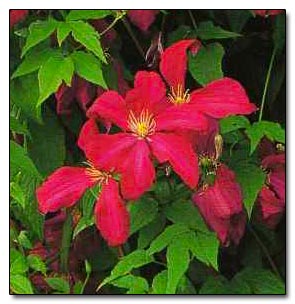Clematis 'Niobe'
Family: Ranunculaceae
Pronounced: KLEM-uh-tiss
Quick Jumps
Growing Guide
Rainy Side Notes
GROWING GUIDE

Origin:
Garden.
Plant Group:
Vines.
Hardiness:
Sunset zones: A-2, A-3, 2-11, 14-24.
USDA zones: 4-11.
Heat zone: 9-1.
Mature size:
Height: 6-10 feet (2.-3 m).
Width: 3 feet (1 m).
Flowering period:
Late spring to early autumn.
Flowering attributes:
Red, six-inch wide with 6-8 tepals. Flowers are deep red when young and fade to red as they age.
Leaf attributes:
Deciduous, green leaves.
Light:
Full sun.
Soil:
Fertile, humus rich, well-drained soil.
Feeding:
Mulch well with composted manure or compost. Fertilize once a month with a complete organic fertilizer during the growing season.
Propagation Methods:
Layer branches in late winter.
Basal and softwood cuttings in spring.
Division in spring.
Semi-ripe cuttings in early summer.
Pruning Methods:
Pruning group 2 or B. You can also prune for group 3 or C; however, you will loose the early flowers that bloom on old wood.
Rainy Side Notes
"Clematis 'Niobe': A large-flowered hybrid, burgundy-red, this cultivar would be in the Clematis Hall of Fame, if there were one." —Linda Beutler
In 1970 'Niobe' came from unknown parentage, originating in Poland, 'Niobe' was raised by Wladyslaw Noll. However, as with all other red-flowering clematis, 'Niobe' has the American native, Clematis texensis, somewhere in its parentage.
This cultivar needs pruning only when first planted to increase the amount of canes. You can hard prune in late winter if necessary; however, in doing so you will lose the early flowers that bloom on old wood. To avoid losing early blossoms, hard prune half of the stems and allow the other half to bloom early. New stems from the hard pruned old wood will produce flowers later in summer. Deadheading will speed up the production of the second wave of flowers. 'Niobe' blossoms make good cut flowers for the vase.
In 1975, Jim Fisk introduced Clematis 'Niobe' to the nursery trade, where it became one of the most popular clematis to grow, many considering it the best. You can grow this vine as a specimen, in a container, or winding its way through medium-sized shrubs. You can train the vine to trail on the ground; when it's in bloom, it makes a stunning ground cover. With this method, you will need to pin the stems along the ground and protect the vine from slugs.
Planting and Care of Clematis.
A Pacific Northwest Plant of the Week (2011)

Gardening for the Homebrewer: Grow and Process Plants for Making Beer, Wine, Gruit, Cider, Perry, and More
By co-authors Debbie Teashon (Rainy Side Gardeners) and Wendy Tweton
Copyright Notice | Home | Search | Vines

